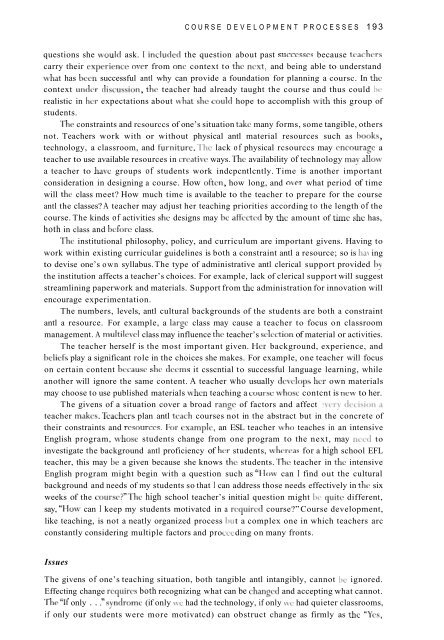Download - Search
Download - Search
Download - Search
Create successful ePaper yourself
Turn your PDF publications into a flip-book with our unique Google optimized e-Paper software.
COURSE DEVELOPMENT PROCESSES 193questions she would ask. I inclutletl the question about past succcsscs because tcachcrscarry their experiencc ovcr from one context to the next, and being able to understandwhat has been successful antl why can provide a foundation for planning a coursc. In thecontext under discussion, the teacher had already taught the course and thus could berealistic in her expectations about lvhat she could hope to accomplish mith this group ofstudents.‘The constraints and rcsourccs of one’s situation take many forms, some tangible, othersnot. Teachers work with or without physical antl material resources such as lmoks,technology, a classroom, and furniturc. The lack of physical rcsourccs may cncouragc ateacher to use available resources in creative ways. The availability of technology may allowa teacher to have groups of students work indcpcntlcntly. Time is another importantconsideration in designing a course. How often, how long, and o\er what period of timewill the class meet? How much time is available to the teacher to prepare for the courseantl the classes? A teacher may adjust her teaching priorities according to the length of thecourse. The kinds of activities she designs may bc affectcd by the amount of timc shc has,hoth in class and before class.The institutional philosophy, policy, and curriculum are important givens. Having towork within existing curricular guidelines is both a constraint antl a resource; so is ha\ ingto devise one’s own syllabus. The type of administrative antl clerical support provided bythe institution affects a teacher’s choices. For example, lack of clerical support will suggeststreamlining paperwork and materials. Support from the administration for innovation willencourage experimentation.The numbers, levels, antl cultural backgrounds of the students are both a constraintantl a resource. For example, a large class may cause a teacher to focus on classroommanagement. A multile\d class may influence the teacher’s selection of material or activities.The teacher herself is the most important given. Her background, experience, andbelicfs play a significant role in the choices she makes. For example, one teacher will focuson certain content becausc she dccms it csscntial to successful language learning, whileanother will ignore the same content. A teacher who usually devclops hcr own materialsmay choose to use published materials whcn teaching a course' whosc contcnt is new to her.The givens of a situation cover a broad range of factors and affectteacher makes. Teachers plan antl teach courses not in the abstract but in the concrete oftheir constraints and rcsourccs. For cxamplc, an ESL teacher hvho teaches in an intensiveEnglish program, whosc students change from one program to the next, may need toinvestigate the background antl proficiency of her students, whcrcas for a high school EFLteacher, this may be a given because she knows the students. The teacher in the intensiveEnglish program might begin with a question such as “IIow can I find out the culturalbackground and needs of my students so that I can address those needs effectively in thc sixweeks of the coursc?”Thc high school teacher’s initial question might be quitc different,say, “How can I keep my students motivatcd in a rcquircd course?” Course development,like teaching, is not a neatly organized process t a complex one in which teachers arcconstantly considering multiple factors and pro ding on many fronts.IssuesThe givens of one’s teaching situation, both tangible antl intangibly, cannot lie ignored.Effecting change rcquircs both recognizing what can be changcd and accepting what cannot.The“If only . . .”syntlromc (if only \ve had the technology, if only we had quieter classrooms,if only our students were more motivatcd) can obstruct change as firmly as the “Yes,


